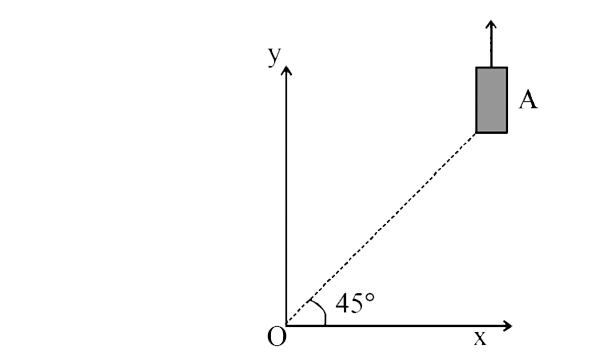If x+iy=√ϕ+iy, where i=√−1 and ϕ and Ψ are non-zero real parameters, then ϕ and Ψ are constants, represents two system of rectangular hyperbola which intersect at an angle of :
π6
π3
π4
π2
The correct Answer is:D
To solve the problem, we start with the equation given in the question:
x+iy=√ϕ+iΨ
where i=√−1 and ϕ and Ψ are non-zero real parameters.
Step 1: Square both sides
To eliminate the square root, we square both sides of the equation:
(x+iy)2=ϕ+iΨ
Step 2: Expand the left-hand side
Expanding the left-hand side using the formula (a+b)2=a2+2ab+b2:
x2+2xyi−y2=ϕ+iΨ
Step 3: Separate real and imaginary parts
Now, we separate the real and imaginary parts:
1. Real part: x2−y2=ϕ
2. Imaginary part: 2xy=Ψ
Step 4: Identify the equations of hyperbolas
From the equations obtained, we can rewrite them as:
1. x2−y2=ϕ (Equation of a hyperbola)
2. 2xy=Ψ (Equation of another hyperbola)
These represent two rectangular hyperbolas.
Step 5: Find the angle of intersection
The angle θ between two curves given by their equations can be found using the formula:
tan(θ)=∣∣∣f′(x0)g′(x0)∣∣∣
where f(x) and g(x) are the equations of the curves, and (x0,y0) is the point of intersection.
For the hyperbolas:
1. From x2−y2=ϕ, differentiating gives:
2x−2yy′=0⟹y′=xy
2. From 2xy=Ψ, differentiating gives:
2y+2xy′=0⟹y′=−yx
Step 6: Calculate the angle of intersection
Now, substituting y′ from both equations into the tangent formula:
tan(θ)=∣∣
∣∣xy−yx∣∣
∣∣=∣∣∣−x2y2∣∣∣
The angle θ between the two hyperbolas can be determined using the formula for the angle between two curves:
tan(θ)=∣∣∣m1−m21+m1m2∣∣∣
where m1 and m2 are the slopes of the tangents at the point of intersection.
Step 7: Conclusion
The two hyperbolas intersect at right angles since their slopes are negative reciprocals of each other. Therefore, the angle of intersection is:
θ=90∘
Final Answer
The two systems of rectangular hyperbolas intersect at an angle of 90∘.
---
2. Imaginary part: 2xy=Ψ
2. 2xy=Ψ (Equation of another hyperbola)
2x−2yy′=0⟹y′=xy
2y+2xy′=0⟹y′=−yx
∣∣xy−yx∣∣
∣∣=∣∣∣−x2y2∣∣∣
Topper's Solved these Questions
- CONIC SECTIONSBOOK - VMC MODULES ENGLISHCHAPTER - CONIC SECTIONSEXERCISE - Numerical Value Type for JEE Main
15 Videos
- CONIC SECTIONSBOOK - VMC MODULES ENGLISHCHAPTER - CONIC SECTIONSEXERCISE - JEE MAIN ARCHIVE
15 Videos
- CONIC SECTIONSBOOK - VMC MODULES ENGLISHCHAPTER - CONIC SECTIONSEXERCISE - LEVEL - 1
178 Videos
- COMPLEX NUMBERS BOOK - VMC MODULES ENGLISHCHAPTER - COMPLEX NUMBERS EXERCISE - JEE ARCHIVE
76 Videos
- DIFFERENTIAL CALCULUSBOOK - VMC MODULES ENGLISHCHAPTER - DIFFERENTIAL CALCULUSEXERCISE - JEE Advanced (Archive)
75 Videos
Similar Questions
Let z=9+ai, where i=√−1 and a be non-zero real.
If Im(z2)=Im(z3), sum of the digits of a2 is
View SolutionIf z=x+iy, where i=√−1, then the equation ∣∣∣(2z−iz+1)∣∣∣=m represents a circle, then m can be
View SolutionLet (−2−13i)3=x+iy27(i=√−1) where x and y are real numbers then y-x equals
View SolutionIf (x+iy)1/3=a+ib,where i=√−1,then(xa+yb) is equal to
View SolutionAt the point of intersection of the rectangular hyperbola xy=c2 and the parabola y2=4ax tangents to the rectangular hyperbola and the parabola make angles θ and ϕ , respectively with x-axis, then
View SolutionLet f(x)=x√a2+x2−d−x√b2+(d−x)2,x∈R, where a, b and d are non-zero real constants. Then,
View SolutionOn a frictionless horizontal surface , assumed to be the x−y plane , a small trolley A is moving along a straight line parallel to the y-axis( see figure) with a constant velocity of (√3−1)m/s . At a particular instant , when the line OA makes an angle of 45(∘) with the x - axis , a ball is thrown along the surface from the origin O. Its velocity makes an angle ϕ with the x -axis and it hits the trolley .
(a) The motion of the ball is observed from the frame of the trolley . Calculate the angle θ made by the velocity vector of the ball with the x-axis in this frame .
(b) Find the speed of the ball with respect to the surface , if ϕ=(4θ)/(3).

View SolutionIf z ∈ C, which of the following relation(s) represents a circle on an Argand diagram? (where,i=√−1)
View Solutionsin−1{1i(z−1)}, where z is non real and i=√−1, can be the angle of a triangle If:
View SolutionLet PM be the perpendicular from the point P(1,2,3) to XY-plane. If OP makes an angle θ with the positive direction of the Z-axies and OM makes an angle Φ with the positive direction of X-axis, where O is the origin, and θandΦ are acute angles , then
View Solution
